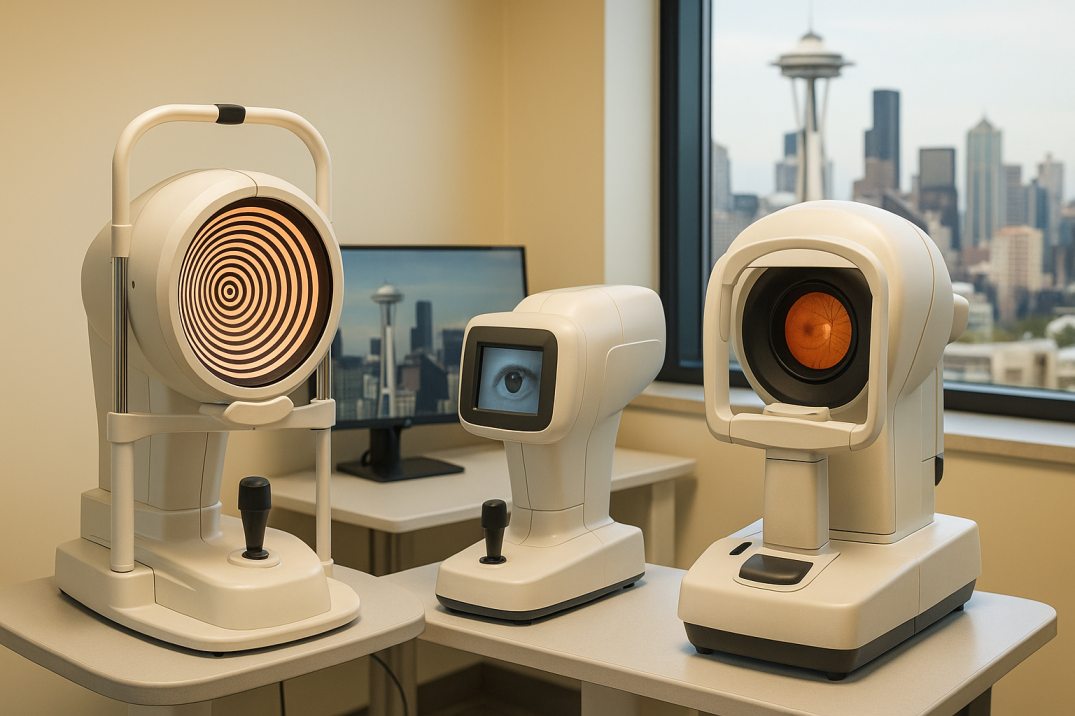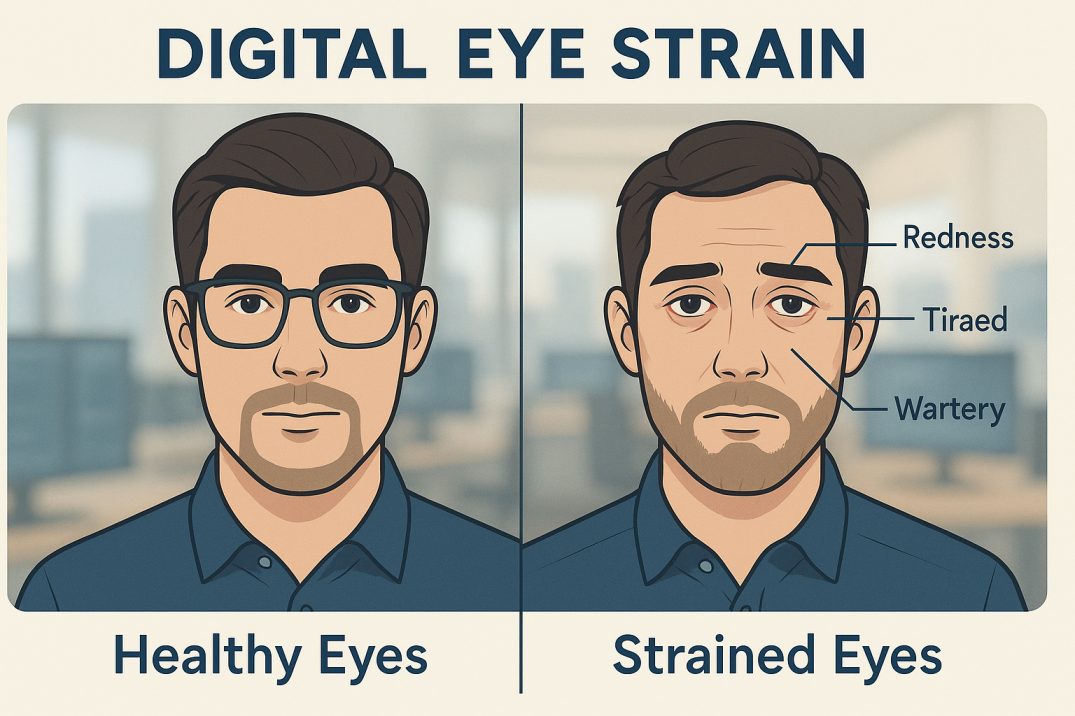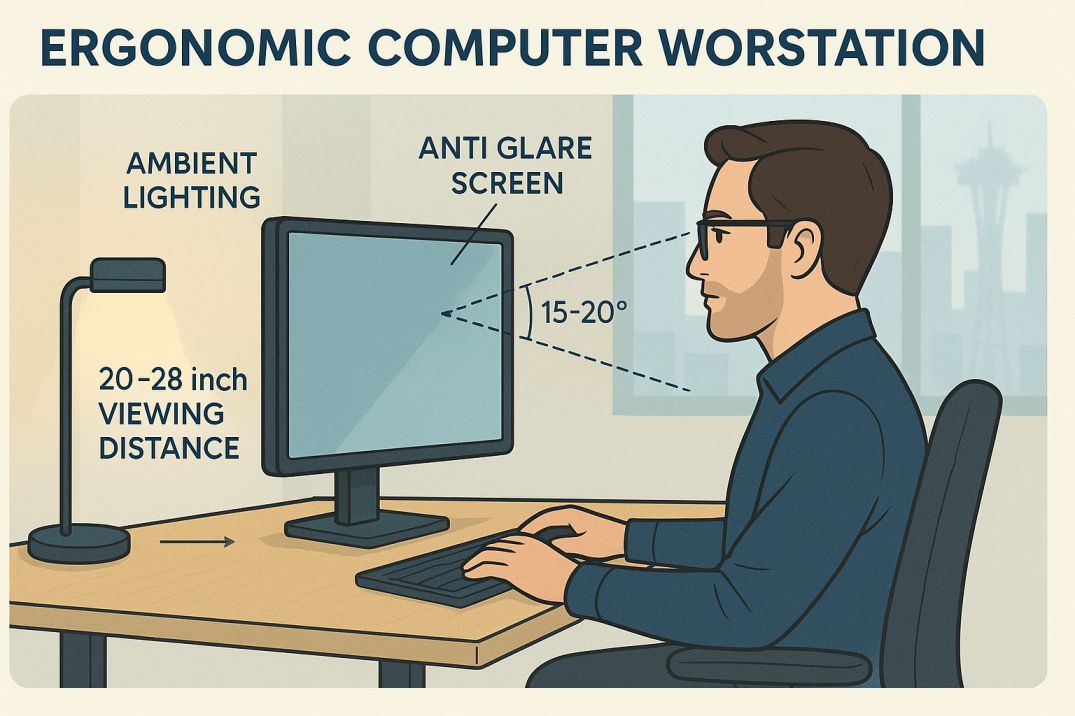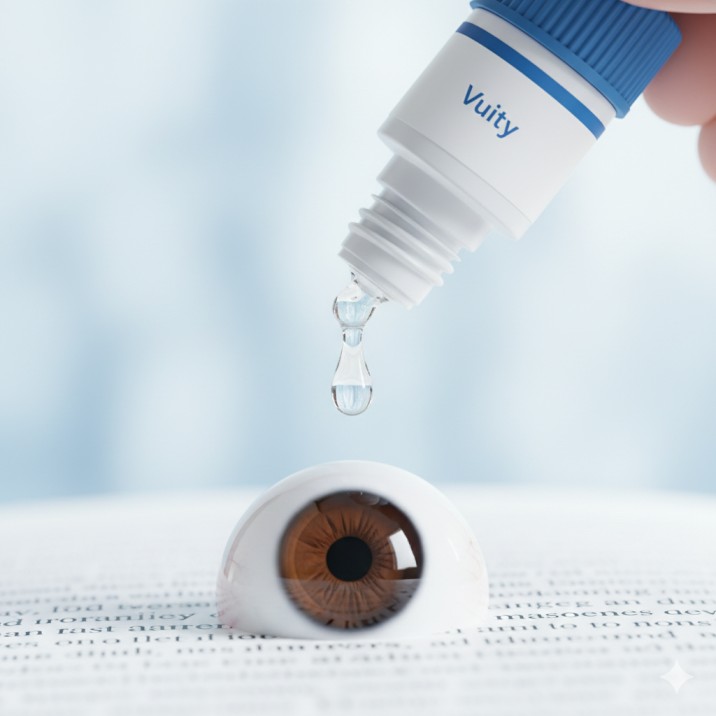Computer Vision Syndrome: Why Seattle Tech Workers Need Specialized Eye Care
Seattle’s tech workers face unprecedented rates of computer vision syndrome, with recent 2025 studies showing a prevalence of 69% in the general population and up to 74% during high screen-time periods. Specialized eye care focusing on comprehensive digital workstation assessments, advanced diagnostic testing, and personalized treatment plans is essential for maintaining long-term eye health and workplace productivity.
Understanding Computer Vision Syndrome in Seattle’s Tech Hub
Seattle is the epicenter of America’s technology revolution, home to tech giants like Amazon, Microsoft, and countless startups. While this digital boom has transformed the city into an innovation powerhouse, it has also created an unexpected health challenge: an epidemic of computer vision syndrome among the workforce. Understanding computer vision syndrome, Seattle’s unique tech environment is crucial for addressing this growing occupational health concern.
Computer vision syndrome affects 69% of the general population, with prevalence influenced by gender, region, and income. However, recent studies during the COVID-19 pandemic revealed that 74% of individuals experienced CVS symptoms due to increased screen time for remote work and online learning. For Seattle’s tech workers, who often spend 10-12 hours daily in front of multiple screens, these statistics represent a critical occupational health concern.
What Is Computer Vision Syndrome?
Computer vision syndrome, also referred to as digital eye strain, describes a group of eye- and vision-related problems that result from prolonged computer, tablet, e-reader, and cell phone use. Unlike traditional eye strain from reading printed materials, CVS stems from the unique visual demands of digital screens.
Key Symptoms Seattle Tech Workers Experience
The symptoms of computer vision syndrome extend far beyond simple “tired eyes.” Eye strain tech workers experience includes dry and irritated eyes, eye strain/fatigue, blurred vision, red eyes, burning eyes, excessive tears, double vision, headache, and light/glare sensitivity.
Primary Visual Symptoms:
- Blurred vision during and after screen use
- Difficulty refocusing between the screen and distant objects
- Double vision or seeing “ghost images”
- Eye strain and fatigue
- Dry, burning, or irritated eyes
Secondary Physical Symptoms:
- Headaches, particularly behind the eyes
- Neck and shoulder pain from poor posture
- Light sensitivity
- Excessive tearing or watering eyes
Productivity-Related Effects:
- Decreased concentration and focus
- Increased error rates in work tasks
- Reduced reading speed and comprehension
- Frequent breaks are needed for eye relief
Why Seattle Tech Workers Are Particularly Vulnerable
Extended Screen Time Culture
As of 2025, the average American spends 7 hours and 3 minutes daily on screens, with this figure remaining stable since 2021. Remote employees spend even more time on screens, averaging nearly 13 hours per day when accounting for work and personal use. Seattle’s tech culture, emphasizing innovation and rapid development cycles, often demands even longer screen exposure periods.
Multi-Device Usage Patterns
DES was reported more frequently by individuals who used two or more devices simultaneously, compared with those using just one device at a time, with prevalences of 75% and 53%, respectively. Seattle tech workers routinely juggle multiple monitors, smartphones, and tablets throughout their workday.
High-Stress Visual Environments
The tech industry’s fast-paced environment compounds visual stress. Eye strain tech workers face is intensified by occupational factors such as monthly income, employment status, and job stress or exhaustion that affect the prevalence of CVS. While higher-paid workers can afford protective equipment, the demanding nature of tech work often leaves little time for proper eye care habits.
Work-From-Home Complications
The shift to remote work has intensified CVS symptoms. 43% of remote workers have signed off early due to vision problems, and 34% have left the office early for the same reason. Home office setups often lack the ergonomic considerations found in corporate environments.
The Science Behind Digital Eye Strain
How Digital Screens Differ from Print
Viewing a computer or digital screen is different than reading a printed page. Often, the letters on the computer or handheld device are not as precise or sharply defined, the level of contrast of the letters to the background is reduced, and the presence of glare and reflections on the screen may make viewing difficult.
The Blinking Factor
Reduced blink rate with computer use has been observed in numerous studies and may be relevant to dry eye symptoms that frequently occur with DES. Reductions in blink rate may be substantial, for example, one study reported a mean rate of 18.4 blinks/min before computer use, decreasing to 3.6 blinks/min during operation.
Blue Light Exposure Concerns
While the role of blue light in CVS remains debated in scientific literature, the use of computers has increased exposure to short-wavelength (450 nm to 495 nm on the high-energy visible light spectrum) light, which is mostly blue light, and can damage the retina and contribute to eye fatigue.
Recent Research Findings Supporting Specialized Care
2025 Comprehensive Literature Review
A comprehensive literature review published in March 2025 analyzing research from 2014 to 2024 confirmed that Computer Vision Syndrome is a growing health concern in the digital age, with a reported prevalence of 69.0%. The study emphasized that CVS is caused by screen-related, environmental, ergonomic, and physiological factors, affecting diverse demographics.
Large-Scale Meta-Analysis Results
A major systematic review and meta-analysis published in Nature in 2023, reviewing 745 research studies from 20 countries, included 103 cross-sectional studies with 66,577 participants. The pooled prevalence of computer vision syndrome was determined to be 66% (95% CI: 59, 74), confirming that nearly two out of every three computer users experience CVS symptoms.
COVID-19 Impact Studies
Recent systematic reviews focusing on the pandemic period found that the combined prevalence of computer vision syndrome reached 74% (95% CI: 66, 81) during COVID-19. This increase demonstrates how changes in work patterns directly impact eye health, particularly relevant for Seattle’s tech workforce that has embraced remote work extensively.
Gender and Demographic Factors
Recent data indicate that DES is a very common problem affecting many millions of individuals. The 2016 Digital Eye Strain report, which included survey responses from over 10,000 US adults, identified an overall self-reported symptom prevalence of 65%, with females more commonly affected than males (69% vs 60% prevalence).
Why Standard Eye Exams Aren’t Enough
Traditional vs. Digital-Focused Assessments
Standard eye exams typically focus on distance vision and basic refractive errors. However, computer vision syndrome requires specialized evaluation of:
- Intermediate Vision Assessment: Most computer work occurs at 20-28 inches, a distance not thoroughly tested in standard exams
- Binocular Vision Function: How well both eyes work together during sustained near work
- Accommodative Flexibility: The eye’s ability to rapidly refocus between different distances
- Tear Film Stability: Critical for comfortable extended screen use
Advanced Diagnostic Technologies
Specialized CVS evaluations employ cutting-edge diagnostic tools:
- Corneal Topography: Maps the surface of the eye to detect subtle irregularities affecting vision quality
- Tear Film Analysis: Measures tear production, stability, and composition
- Retinal Photography: Documents the health of internal eye structures
- Visual Field Testing: Assesses peripheral vision that may be affected by prolonged screen use
Comprehensive Treatment Approaches for Seattle Tech Workers
Effective digital eye strain treatment requires a multi-faceted approach tailored specifically to the demands of Seattle’s tech industry. Understanding that eye strain tech workers experience differs from general computer users, specialized treatment protocols address both immediate symptoms and long-term eye health maintenance.
Personalized Lens Solutions
Computer-Specific Eyewear:
- Anti-reflective coatings to reduce glare from multiple light sources
- Slight magnification to reduce accommodation stress
- Precise intermediate distance prescriptions
- Blue light filtering (when appropriate for individual cases)
Progressive and Occupational Lenses: For tech workers over 40, specialized progressive lenses designed for computer use offer:
- Wider intermediate zones for comfortable screen viewing
- Reduced distortion in peripheral areas
- Smooth transitions between viewing distances
Environmental Optimization Strategies
- Monitor positioning 15-20 degrees below eye level
- Viewing distance of 20-28 inches from the screen
- Ambient lighting adjustments to minimize glare
- Humidity control to prevent dry eye symptoms
The Enhanced 20-20-20 Rule: Take a 20-second break to view something 20 feet away every 20 minutes. For tech workers, this should be supplemented with:
- Deliberate blinking exercises every 10 minutes
- Take micro-breaks every hour for eye muscle relaxation
- End-of-day eye care routines
Advanced Treatment Modalities
Dry Eye Management: Specialized digital eye strain treatment protocols include:
- Prescription artificial tears optimized for screen use
- Punctal plugs to conserve natural tears
- Anti-inflammatory treatments, when indicated
- Lifestyle modifications specific to tech work environments
Vision Therapy: Some computer users experience problems with eye focusing or eye coordination that can’t be adequately corrected with eyeglasses or contact lenses. A program of vision therapy may be needed to treat these specific problems.
The Economic Impact of Untreated Computer Vision Syndrome
Productivity Costs
According to a 2024 report by the American Optometric Association and the Deloitte Economics Institute, unmanaged screen time generated health system, productivity, and personal wellbeing costs equivalent to an estimated $151 billion in 2023. Studies indicate that 66 to 74 percent of computer users suffer from visual symptoms of computer vision syndrome. These symptoms include eye strain, dry eyes, eye irritation, blurred vision, and double vision. For Seattle’s high-tech workforce, this translates to:
- Decreased accuracy in coding and data analysis tasks
- Longer completion times for visual work (up to 20% increase)
- Increased sick leave usage (3 in 5 people with eye conditions miss full or partial days of work within 4 weeks)
- Higher turnover rates in visually demanding positions
- Approximately 74% of employees report that their eye conditions affect work productivity
Return on Investment for Employers
Based on University of Alabama at Birmingham research and recent economic analyses, companies investing in comprehensive eye care programs report:
- 5-10% improvement in task completion times (conservative estimates from UAB studies)
- Reduced workers’ compensation claims related to repetitive strain injuries
- Higher employee satisfaction and retention rates
- Decreased healthcare costs related to musculoskeletal disorders
- Potential annual cost savings of $1,262 per computer worker (based on UAB productivity studies, adjusted for current wage levels)
Choosing the Right Eye Care Provider in Seattle
Finding appropriate computer vision syndrome Seattle treatment requires identifying providers who specialize in occupational eye health and understand the unique demands of the tech industry. The specific type of eye strain that tech workers face requires specialized diagnostic approaches and treatment protocols beyond standard eye care.
Essential Qualifications to Look For
Specialized Training:
- Board certification in optometry or ophthalmology
- Additional training in occupational vision and computer vision syndrome
- Experience with digital eye strain assessment and treatment
- Knowledge of workplace ergonomics and visual demands

Advanced Technology:
- Modern diagnostic equipment for comprehensive eye health assessment
- Tear film analysis capabilities
- Custom lens design and fitting expertise
- Integration with occupational health programs
Questions to Ask During Your Consultation
- How do you assess visual demands specific to my work environment?
- What diagnostic tests do you perform beyond standard vision screening?
- How do you customize treatment plans for different types of tech work?
- What follow-up care is included in your CVS management program?
- How do you coordinate with workplace wellness programs?
Prevention Strategies for Long-Term Eye Health
Workplace Wellness Integration
Corporate Eye Health Programs:
- Annual comprehensive eye exams with CVS focus
- Workstation ergonomic assessments
- Employee education on digital eye strain prevention
- Access to specialized computer eyewear
Individual Prevention Practices:
- Regular eye exam schedule (annually or as recommended)
- Consistent use of prescribed computer eyewear
- Implementation of break schedules and eye exercises
- Awareness of symptoms requiring immediate attention
Emerging Technologies and Future Solutions
Smart Workplace Integration:
- Automated lighting systems that adjust to screen content
- Smart glasses with built-in blue light filtering and eye tracking
- AI-powered break reminders based on blink rate monitoring
- Ergonomic workstation adjustments based on real-time posture analysis
When to Seek Immediate Care
Red Flag Symptoms
Seek prompt professional evaluation if experiencing:
- Sudden onset of severe eye pain
- Persistent double vision
- Significant vision changes that don’t improve with rest
- Severe headaches accompanied by vision changes
- Light sensitivity that interferes with daily activities
Regular Monitoring Schedule
For Asymptomatic Tech Workers:
- Comprehensive eye exam annually
- CVS-focused assessment every 6-12 months
- Workstation ergonomic review annually
For Those with Existing Symptoms:
- Initial comprehensive evaluation
- Follow-up at 3-6 month intervals
- Ongoing monitoring and treatment adjustment as needed
Seattle-Specific Resources and Recommendations
Local Eye Care Providers
When seeking CVS-specialized care in Seattle, prioritize providers who:
- Understand the unique demands of tech industry work
- Offer comprehensive digital eye strain evaluations
- Provide personalized treatment plans
- Have experience with local corporate wellness programs
Insurance Considerations
Many Seattle-area employers offer vision benefits that cover:
- Annual comprehensive eye exams
- Computer-specific eyewear
- Treatment for diagnosed vision disorders
- Ergonomic workplace assessments
Conclusion: Protecting Your Vision in Seattle’s Digital Future
Computer vision syndrome represents a significant occupational health challenge for Seattle’s thriving tech workforce. Recent comprehensive research from 2024-2025 confirms that CVS affects 66-69% of the general population, with pandemic-related studies showing rates as high as 74% during periods of increased screen time.
The evidence is clear: standard eye care approaches are insufficient for addressing the complex visual demands of modern tech work. The 2024 Deloitte Economics Institute report documenting $151 billion in annual costs from unmanaged screen time underscores the critical need for specialized computer vision syndrome care that combines comprehensive digital workstation assessment, advanced diagnostic testing, and personalized treatment plans.
Seattle’s tech workers deserve eye care solutions as innovative as the technologies they create. By prioritizing specialized computer vision syndrome care, both individuals and employers can ensure that the region’s digital revolution doesn’t come at the cost of vision health.
The investment in proper eye care today prevents more serious complications tomorrow, ensuring that Seattle’s tech workforce can continue driving innovation while maintaining optimal eye health throughout their careers.
FAQs
-
Computer vision syndrome (CVS) is eye strain from prolonged screen use, causing symptoms like blurry vision, headaches, and dry eyes—common among tech workers due to long hours at digital devices





